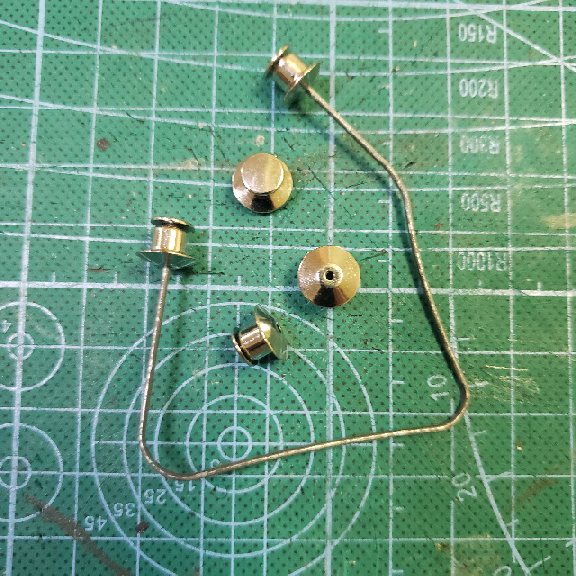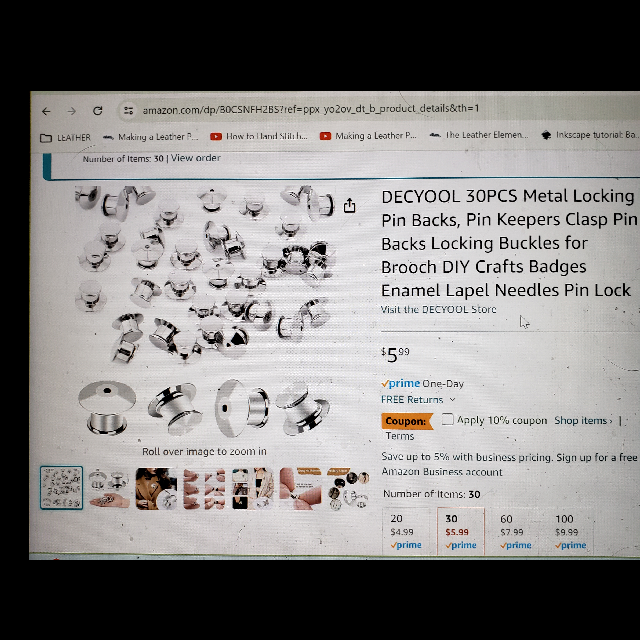-
Posts
1,280 -
Joined
Content Type
Profiles
Forums
Events
Blogs
Gallery
Everything posted by SUP
-
Check this. It give some idea about needles and threads. I do as @MarshalWill does too - keep a small pair of pliers handy.
-
You don't need to push 2 needles in at the same time, no matter what some of the teaching videos say. Check this video - it teaches yo how to stitch the angled stitches as well, pushing through one needle at a time.
-

Angled stitches with round stitching holes - how do I do that?
SUP replied to SUP's topic in Sewing Leather
@NatesLeatherGds . -

Angled stitches with round stitching holes - how do I do that?
SUP replied to SUP's topic in Sewing Leather
Found it!I had it in my collection of videos. It is a video by Nigel Armitage - at around 8 1/2 minutes. -

Angled stitches with round stitching holes - how do I do that?
SUP replied to SUP's topic in Sewing Leather
@Northmount Thank you. I'll try that. -

Angled stitches with round stitching holes - how do I do that?
SUP replied to SUP's topic in Sewing Leather
@DieselTech Yes I remember that it is all about the casting and how to pull the thread. I am still searching. It should be somewhere. -

Angled stitches with round stitching holes - how do I do that?
SUP replied to SUP's topic in Sewing Leather
@Northmount, thank you. I should have thought of that. I have but not found anything specifically for angled stitches with round stitching holes. Maybe my search terms need to be better. -
Angled stitches with Diamond chisel or French chisel punched holes are something I can do relatively well now. However, some patterns that I buy have round holes which result in straight stitches. There is one pattern on which I want the stitches to be angled. I do have the correct sized diamond stitching chisels but the pattern is a little complicated and I am concerned that I will punch the pieces in the wrong direction and make a mess of it. I do not have spare leather of that specific type for corrections. So I'm wondering if there is a way to get some angle on the stitches when the punched holes are round? I have a vague recollection of a video somewhere that showed how to do it but I can't, for the life of me, find it. Anyone who knows how to do this, could yo please guide me?
-
@AndreaRotelathis is a tutorial about how to wet form a bag, not about laser engraving, and certainly not a place to advertise your product by suggesting a shortcoming in an excellent tutorial. @MagiKelly, your tutorial is excellent as people have said here over the years, nothing else needed. It is the go-to to learn how to wet form a bag for so many of us.
-
@toxo Aha. Got it. I just use a few each time, just sufficient for the current stitching session. These new pin-backs might hold for longer though. I will let you know when I use them. I use old U-clips which feel a bit rough and probably stay in place better than shiny, smooth new ones.
-
@toxo These things don't need to be fancy, do they? Whatever works.
-
-
@DavidR1990 That is a beautiful bag. It is a drawstring bag - you can see the tasseled drawstring on either side of the buckled strap - with a tooled panel stitched around the front and back. This panel seems to go around from the front, form a base to rest the bag on and up the back and more, to form the front closure flap. There is another piece connected to the back of this panel, which connects to the ring and the base of the panel connects to those straps. I have made a similar one although not so lovely. I am still only a year into leatherworking. While such bags look beautiful, they are rather impractical to use. Each time, to open the bag, one needs to open the buckle, then the drawstring, then loosen the opening before reaching in, then repeat the steps in reverse to close the bag. So as an example, this is great but usability? Not so much, at least for people like me. I've seen similar patterns for sale on Etsy. You could check there, at least for the attachment of the panel to the pouch and the general shape, then modify from there.
-
@fredk exactly. Plenty of sizes of earrings to suit one's purpose. I have started using those larger earring backs too. They are flat and the thread does not get entangled in them.
-
These are what I DON"T like, @Frodo and why I started this thread. These pins are very sharp and can easily scratch the leather as I try to place them and the pin backs are heavy and unwieldy. The thread keeps constantly getting entangled in them because of their particular design as well. Mine are just thrown aside, with bloody fingers. That is why I use inexpensive earrings all the time, as I explained here. They work great but the backs are small and can come loose. Therefore, these pin-backs might work with the U-clips idea from @Northmount. or with slightly larger earrings... let's see. All trial and error until I reach a good solution.
-
@Frodo I think so too. Versatile little things, if they work. @NatesLeatherGds I'll get back on whether they work... or not.
-
@Frodo not yet. When I do use my sewing machine, I'll remember that. @Northmount Just discovered something on Amazon today to use with those paper clip pieces. These pin-backs work like the backs on those stitch holders which are the rage today - that I described at the start of this thread. They can be used on anything which fits, from name tags to brooches to badges. I have ordered them already.
-
I found this video while looking for something else. It shows more or less what I do, although I use a primer at first. I got something from the same place earlier via Etsy. how to burnish leather edgeseasy&fastبه راحتی رنگ لبه بزن_سریع و آسان - YouTube
-

Help with getting a nice frayed belt edge with fibers
SUP replied to blackandblue50's topic in How Do I Do That?
Diluted black dye might give you that dark grey color. You could try it on a piece of scrap first. -
The results look nice but look evidently machine-made and not hand-made, at least what is shown on their site.
-
Oh, I will. I'm always getting cuts during stitching, and those are deep, so I'm very careful. That is why I started this thread as well - to pass on info I have about non-sharp stitch holders. In the process I got more ideas, which is nice.
-
@Northmount Thank you. That is so easy to make and use. They are blunt and strong, just what leatherworkers need.
-
@DwightT you are right about the impersonal nature of the Internet. But see, an internet search is one thing; a specific question asked and answered becomes a conversation. Isn't it? @DwightT, @jrdunn You both are two of the many who do respond appropriately. The number who don't are only a few on this forum, thankfully. Anyway, once in a while is no issue. We all get busy sometimes and miss responding. It is when something is specifically asked and specifically responded to, within a few hours and then the asker does not say anything at all, that is what gets to me. Anyway, no sweating the small stuff. Like I say to all and sundry, the people here, for the most part, are wonderful and that is what I prefer to see and keep in mind.
-

Does anyone have a good saddle soap receipe
SUP replied to ToddW's topic in Leatherwork Conversation
I usually clean my leathers with a dilute solution of Dawn dishwashing liquid, dry it and then condition it. I have tried saddle soap and it was not much different anyway.




